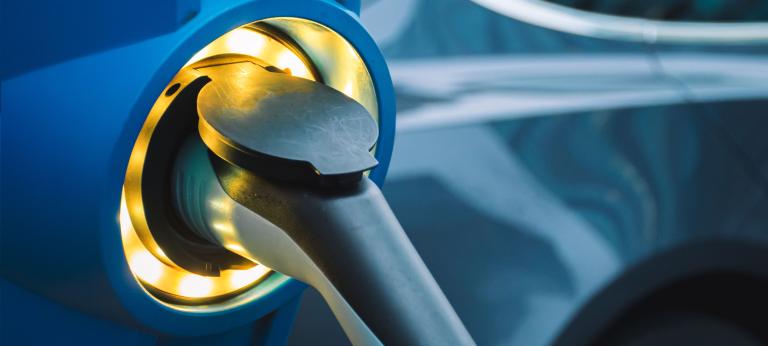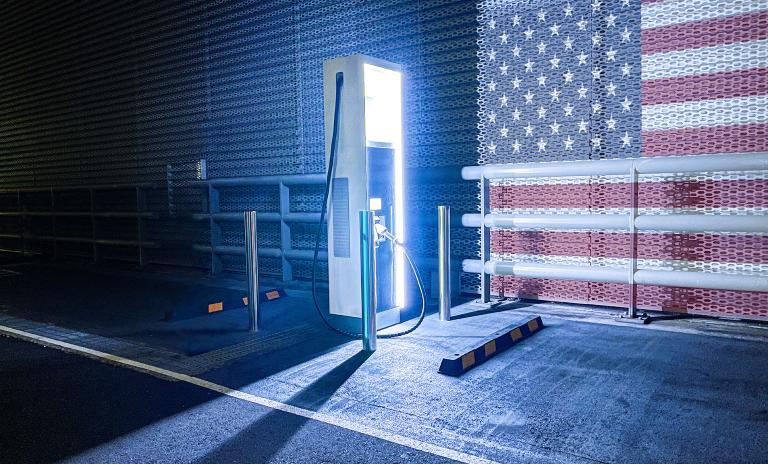EV Charging Index: Expert insight from the United States
![{[downloads[language].preview]}](https://www.rolandberger.com/publications/publication_image/23_2077_ART_EV_charging_index_deep_dive_USA_Cover_download_preview.jpg)
EV sales remain low but are rising rapidly in an increasingly dynamic US e-mobility market. Find out more in Roland Berger’s EV Charging Index 2023.


By Erin Sowerby
While EV adoption in the United States is still behind the global average, it is beginning to rise rapidly. The government has introduced significant financial incentives and OEMs are now offering greater choice to appeal to a broader range of customers. Big changes are coming to the public charging ecosystem as the Tesla SuperCharger network opens up, acceptance of the Tesla standard broadens, and a coalition of automakers announces a new fast-charging network.

In general, the tone in the US is not an aspiration for ‘global leadership’, rather an increasingly positive mix of themes that have a beneficial impact on EV adoption : energy independence, improved performance and better fit for preferred lifestyles. The significant subsidies for purchase in the Inflation Reduction Act (IRA) – up to USD 7,500 – and price cuts from major OEMs are adding to the perception that EVs are entering the mainstream, with charging logistics and experience displacing the traditional concerns of affordability and technology risk. The recent major consolidation around the Tesla charging standard and network is an important step.
More than most other global markets, the US is embracing larger EVs such as Rivian’s R1 range, Ford’s F-150 Lightning and SUV models from existing OEMs. Given their large battery sizes, this necessitates proliferation of DC charging and accelerates obsolescence of many early ‘convenience’ chargers as 7kW/hr has minimal impact on an SUV or truck with a 135kw battery.
There is an emerging awareness of the volatility of gasoline pricing versus the relative stability of retail electricity rates. However, as consumers move towards more DC public charging, the rates for those sites are significantly higher than retail electricity, and perhaps not-coincidentally, similar to ‘per gallon’ equivalence with gasoline. That said, most American EV owners do the vast majority of their charging at home at a much lower cost.
The EV sales penetration rate has steadily increased over the last several years, up to 8% of passenger vehicles in the second half of 2022 and moving higher in the first half of 2023. This is still behind the global average of 16% and well below the top countries, but it is a significant increase over the penetration rate of 4% indicated in our first edition, only two years ago. A key driving factor is the variety of new models from OEMs, including a much larger number of lower-cost options, changing the profile of the typical EV owner. The expansion of the charging network is a major facilitator for EV adoption as consumers continue to indicate range anxiety and inconvenience as a major roadblock to adoption.
Home charging dominates as most US EV owners have a dedicated garage space and it remains the most convenient and cost-effective charging option. For public charging, charge-point operators (CPOs) are recognizing that consumers want faster charging and a better customer experience. To this end, CPOs are swapping out older, slower chargers for higher-capacity fast chargers and upgrading the user experience, focusing on safety, convenience and cleanliness. None currently meet the standards of the Tesla SuperCharger network. This is evidenced by some OEMs announcing plans to utilize the Tesla network, with others forming a coalition to build their own network.
A large part of the IRA focused on incentives for battery electric vehicles, including direct rebates for the end consumer. These are powerful incentives, lowering the upfront cost of the vehicles closer to traditional ICE vehicles. The infrastructure bill, passed in 2021, contains the majority of federal funding focused on infrastructure development, although the IRA does contain an extension of the investment tax credit on charging infrastructure. It is unlikely there will be more legislation at the federal level and there remains an outside possibility that with a change in administration, there could be a claw-back of some of the IRA funding.
Future incentives and requirements are likely at the state and local level, however. Programs seen in California and New York to pay for customer upgrades for charging stations could be replicated in other states. Utilities are also working on EV-specific rates, where EV owners and/or charging stations will have lower rates, potentially in exchange for shifting the time that they charge into off-peak hours. This can have a significant impact on the cost of operating commercial fleets, making electrification a much more attractive option for fleet owners.
There has been a major challenge to the supremacy of the combined charging system (CCS) plug in the US. Last year, Tesla shared the design of their plug, renaming it the North American Charging Standard (NACS), in an attempt to make it the standard in North America. There was little positive reaction at the time, but recently their efforts are paying off as they are making major inroads across the charging ecosystem. Ford, quickly followed by GM and Rivian, have announced plans to integrate the NACS technology into their new EVs and sell adapters for current EV owners to gain access to Tesla’s Supercharger network. The charging ecosystem has quickly followed suit, with over a dozen charger manufacturers and CPOs announcing that the NACS plus will be added to their chargers. A coalition of automakers - BMW, General Motors, Honda, Hyundai, Kia, Mercedes-Benz and Stellantis - recently announced a plan to build at least 30,000 fast chargers in highway and urban locations throughout North America. These chargers will utilize both NACS and CCS plugs. The automakers recognize customer dissatisfaction with the reliability, safety and comfort of most public charging networks.
We should carefully watch to see the response from non-Tesla owners as they use the Supercharger network. Is the ‘secret sauce’ behind the success of the SuperCharger network transferable to non-Tesla vehicles? Will the same issues with reliability and connectivity pop up if there isn’t seamless communication between the vehicle and charger? We will need to observe the transition and any bumps in the road.
“Knowable” future innovations and challenges have yet to become significant in policy, infrastructure and supply planning, and state-level regulatory models for electricity delivery will continue to lag the potential pace of innovation. Certain innovations in battery technology – solid state, circularity, charging performance, DC infrastructure – will occur at the high end, while lower-cost technologies from around the world, such as LFP batteries, should also proliferate. At some point, consumer preferences should ideally move towards ‘optimization’ of battery size and therefore vehicle weight and cost, instead of the ‘maximum performance, maximum range, fastest charging’ we currently see in our surveys and custom surveys for clients.
There are five main developments to watch:
![{[downloads[language].preview]}](https://www.rolandberger.com/publications/publication_image/23_2077_ART_EV_charging_index_deep_dive_USA_Cover_download_preview.jpg)
EV sales remain low but are rising rapidly in an increasingly dynamic US e-mobility market. Find out more in Roland Berger’s EV Charging Index 2023.
Sign up for our newsletter and get regular updates on Automotive topics.